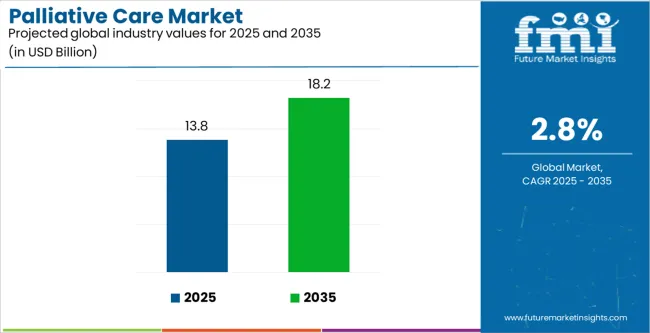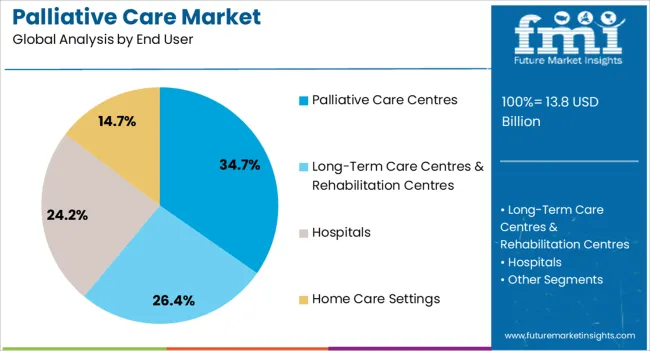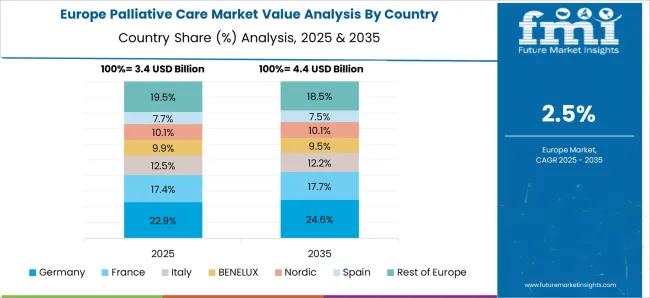The palliative care market is expected to grow from USD 13.8 billion in 2025 to USD 18.2 billion by 2035, expanding at a CAGR of 2.8%. Demand growth shows the increasing recognition of palliative services as an essential component of healthcare, focusing on quality of life, pain management, and holistic support for patients with serious illnesses. Regional dynamics reveal distinct patterns shaped by healthcare infrastructure, demographic shifts, and policy frameworks. North America is expected to remain a leading region, supported by strong healthcare systems, favorable reimbursement policies, and advanced training programs for palliative specialists. The U.S. market, in particular, benefits from widespread awareness of palliative care options, integration into hospitals and hospices, and rising acceptance of home-based services. The aging population further accelerates demand, with healthcare providers embedding palliative practices into chronic disease management.
In Europe, the market outlook is characterized by structured healthcare frameworks and strong government-backed initiatives. Countries such as the UK, Germany, and France have emphasized national strategies to expand palliative care availability, with hospital and community-based services growing steadily. The European Union’s policies supporting end-of-life care and multidisciplinary team approaches are also fueling adoption. Europe’s emphasis on integrating palliative care into oncology, cardiology, and neurological treatments is reshaping care delivery models, with hospices and outpatient centers gaining traction.
Asia-Pacific is anticipated to record the fastest growth, driven by demographic pressures and shifting healthcare priorities. Countries such as China, India, and Japan are facing rapidly aging populations and a rising prevalence of non-communicable diseases, creating urgent demand for supportive care models. While awareness and infrastructure remain uneven across the region, initiatives led by both governments and non-governmental organizations are expanding training programs and facilities. Japan’s advanced healthcare system has enabled strong integration of palliative care, while India is emerging as a focus market with growing advocacy for community-level services. This region’s growth is underpinned by rising cultural acceptance of comfort-oriented care and increasing partnerships between international organizations and local health systems.
In Latin America, the Middle East, and Africa, adoption remains gradual, but the trend is upward. Countries such as Brazil, South Africa, and Saudi Arabia are making incremental progress through hospital-based initiatives and non-profit organizations. Limited specialist availability and funding challenges continue to constrain growth, but international aid and pilot programs are introducing scalable models. These regions are expected to gradually strengthen palliative care capacity as awareness campaigns, policy support, and training initiatives expand.
The regional landscape demonstrates that while developed economies are leading in infrastructure and integration, emerging economies present untapped opportunities for expansion. Global momentum is shifting toward recognizing palliative care as a critical pillar of healthcare delivery, ensuring comfort, dignity, and comprehensive support for patients and families by 2035.

| Metric | Value |
|---|---|
| Palliative Care Market Estimated Value in (2025 E) | USD 13.8 billion |
| Palliative Care Market Forecast Value in (2035 F) | USD 18.2 billion |
| Forecast CAGR (2025 to 2035) | 2.8% |

The market is segmented by Service Type and End User and region. By Service Type, the market is divided into Hospice Inpatient Care, Hospital Inpatient Care, Nursing Home And Residential Facility Care, Private Residence Care, and Others. In terms of End User, the market is classified into Palliative Care Centres, Long-Term Care Centres & Rehabilitation Centres, Hospitals, and Home Care Settings. Regionally, the market is classified into North America, Latin America, Western Europe, Eastern Europe, Balkan & Baltic Countries, Russia & Belarus, Central Asia, East Asia, South Asia & Pacific, and the Middle East & Africa.

The hospice inpatient care segment is projected to hold 29.8% of the market revenue in 2025, establishing it as the leading service type. Growth in this segment is being driven by the increasing need for round-the-clock medical support, pain management, and emotional care for patients with terminal illnesses. Hospice inpatient services provide dedicated clinical oversight, ensuring continuity of care and enhanced comfort during end-of-life management.
Integration of palliative interventions with nursing, counseling, and rehabilitation services further improves patient outcomes. The ability to deliver tailored treatment plans while supporting families and caregivers enhances acceptance and preference among healthcare providers and patients.
Rising awareness of the benefits of hospice inpatient care, coupled with expanding availability in specialized hospitals and care centers, has reinforced adoption As healthcare systems increasingly emphasize compassionate, patient-centered care models, hospice inpatient care is expected to maintain its market leadership, supported by growing demand for high-quality end-of-life services and specialized clinical support.

The palliative care centres segment is anticipated to account for 34.7% of the market revenue in 2025, making it the leading end-user category. Growth in this segment is being driven by the increasing establishment of dedicated facilities that provide multidisciplinary care for patients with chronic or terminal illnesses. These centers integrate medical, emotional, and social support services, ensuring comprehensive patient care while facilitating caregiver guidance and community support.
The ability to deliver coordinated care in specialized environments enhances patient comfort, reduces hospital admissions, and improves overall treatment outcomes. Investments in infrastructure, skilled personnel, and digital care management systems are supporting the expansion of palliative care centres globally.
Government initiatives and policy support aimed at improving accessibility and affordability of palliative care services further reinforce adoption As demand for specialized and holistic care continues to rise, palliative care centres are expected to remain the primary end-user segment, with ongoing investments and innovation enhancing service delivery and patient experience.
In 2020, the global palliative care market showed a potential worth USD 12 billion, according to Future Market Insights (FMI). The palliative care market witnessed significant growth, registering a CAGR of 8.50% from 2020 to 2025.
| Historical CAGR | 8.50% |
|---|---|
| Forecast CAGR | 2.8% |
The significant development of the market indicates a propelling awareness and adoption of palliative care services worldwide. Factors contributing to this improvement include the increase in geriatric populations, the development of the prevalence of chronic diseases, and evolvement in healthcare policies emphasizing patient-centered care.
Upgradations in palliative care treatments and therapies have secured the quality of life for patients with serious illnesses. The historical forecasted CAGR of 8.50% from 2020 to 2025 suggests a potential slowdown in market growth, mainly due to challenges such as healthcare system limitations, inadequate access to palliative care services, and economic constraints.
Despite the projected downtrend, the market remains integral to healthcare, offering comprehensive support and symptom management for individuals with life-limiting illnesses.
The below section shows the leading segment. Based on the service type, the hospital inpatient care segment is accounted to hold a market share of 29.8% in 2025. Based on end-users, the palliative care centers segment is accounted to hold a market share of 34.7% in 2025.
Patients require acute medical interventions and specialized care within hospital settings due to the prevalence of chronic and life-limiting illnesses.
Palliative care centers offer specialized care tailored to the unique needs of patients with life-limiting illnesses, explicitly provides holistic support that encompasses physical, psychosocial, and spiritual aspects of care.
| Category | Market Share in 2025 |
|---|---|
| Hospital Inpatient Care | 29.8% |
| Palliative Care Centers | 34.7% |
Based on the service type, the hospital inpatient care segment stands out, capturing a significant market share of 29.8%. Hospital inpatient care involves providing palliative care services within hospital settings, which caters to patients with complicated medical needs or those that require intense symptom management.
The segment prominently highlights the important role of hospitals in delivering palliative care, generally for patients with progressive illnesses who require specialized medical attention and comprehensive support services.
Based on end-users, the palliative care centers are accounted to hold a market share of 34.7% in 2025 underscoring the importance of dedicated palliative care facilities. Palliative care centers offer a holistic approach to their patients, focusing on symptom management, psychosocial support, and quality of life for individuals with life-limiting illnesses.
The centers contribute to a supportive environment helpful to comprehensive care delivery, encouraging collaborations among interdisciplinary teams and promoting patient and family-centered approaches to palliative care.
The table describes the top five countries ranked by revenue, with France holding the top position.
France leads the palliative care market because its robust healthcare system integrates palliative care into various settings. The country boasts extensive hospice and palliative care facilities, ensuring comprehensive support for patients with life-limiting illnesses.
France prioritizes interdisciplinary collaboration among healthcare professionals, promoting a patient-centered approach to palliative care that highlights quality of life and holistic support for patients and families.
Forecast CAGRs from 2025 to 2035
| Countries | CAGR through 2035 |
|---|---|
| United States | 1.9% |
| Germany | 3% |
| France | 4.8% |
| Italy | 4.2% |
| Spain | 3.8% |

The palliative care market is primarily utilized within healthcare institutions, including hospitals, hospices, and long-term care facilities.
Palliative care services are unified into the broader healthcare system to provide comprehensive support for patients with serious illnesses, focusing on symptom management, pain relief, and psychosocial support alongside curative treatments.

Palliative care is progressively utilized in community settings, encircling home-based care, outpatient clinics, and community palliative care teams. The emphasis is placed on delivering palliative care services in local healthcare centers, promoting continuity of care.
The palliative care market is primarily utilized in specialized units providing comprehensive care services. The units are often located within hospices and offer multidisciplinary care tailored to the needs of patients with advanced illnesses, focusing on pain management, symptom control, and end-of-life care in a supportive and specialized environment.
Palliative care is integrated into wider healthcare networks that envelop hospitals, primary care centers, and community-based services.
Palliative care teams cooperate with various healthcare professionals to deliver holistic care across different settings that ensure continuity of support for patients and families throughout the illness trajectory.
The market provides long-term care facilities, including nursing homes and residential homes for the elderly.
Such care services are integrated into long-term care settings to address the complex needs of elderly patients with incurable and life-limiting illnesses that emphasize comfort, dignity, and quality of life in a supportive and compassionate environment.

The palliative care market features a mix of established healthcare providers, specialized palliative care centers, and hospice organizations. Entrenched players leverage their experience and infrastructure and offer comprehensive palliative care services, while imminent entrants focus on niche segments or innovative service models.
With the boost in demand for palliative care services, competition intensifies, propelling providers to discriminate through the quality of care, service offerings, and patient-centered approaches that ultimately strive to meet the mellowing needs of patients and families who suffer from serious illness.
Some of the key developments
| Attributes | Details |
|---|---|
| Estimated Market Size in 2025 | USD 13.45 billion |
| Projected Market Valuation in 2035 | USD 17.73 billion |
| Value-based CAGR 2025 to 2035 | 2.8% |
| Forecast Period | 2025 to 2035 |
| Historical Data Available for | 2020 to 2025 |
| Market Analysis | Value in USD billion |
| Key Regions Covered | North America; Latin America; Western Europe; Eastern Europe; South Asia and Pacific; East Asia; Middle East and Africa |
| Key Market Segments Covered | Service Type, End User, Region |
| Key Countries Profiled | The United States, Canada, Brazil, Mexico, Germany, The United Kingdom, France, Spain, Italy, Russia, Poland, Czech Republic, Romania, India, Bangladesh, Australia, New Zealand, China, Japan, South Korea, GCC countries, South Africa, Israel |
| Key Companies Profiled | Center to Advance Palliative Care (CAPC); UCLA Health; National Hospice and Palliative Care Organization; Vitas Healthcare Corporation; CHI Franciscan; University of Washington (UW Medical Center & UW Medicine); Seymour Health; KEHPCA (Kenya Hospices and Palliative Care Association); Sunrise Senior Living LLC |
The global palliative care market is estimated to be valued at USD 13.8 billion in 2025.
The market size for the palliative care market is projected to reach USD 18.2 billion by 2035.
The palliative care market is expected to grow at a 2.8% CAGR between 2025 and 2035.
The key product types in palliative care market are hospice inpatient care, hospital inpatient care, nursing home and residential facility care, private residence care and others.
In terms of end user, palliative care centres segment to command 34.7% share in the palliative care market in 2025.






Full Research Suite comprises of:
Market outlook & trends analysis
Interviews & case studies
Strategic recommendations
Vendor profiles & capabilities analysis
5-year forecasts
8 regions and 60+ country-level data splits
Market segment data splits
12 months of continuous data updates
DELIVERED AS:
PDF EXCEL ONLINE
Veterinary Palliative Care Management Market
Suncare Products Market Size and Share Forecast Outlook 2025 to 2035
Skincare Supplement Market Size and Share Forecast Outlook 2025 to 2035
Skincare Oil Market Size and Share Forecast Outlook 2025 to 2035
Lip Care Market Analysis - Size and Share Forecast Outlook 2025 to 2035
Skincare Nutritional Serum Market Size and Share Forecast Outlook 2025 to 2035
Haircare Supplement Market - Size, Share, and Forecast Outlook 2025 to 2035
Skincare Products Market Size and Share Forecast Outlook 2025 to 2035
Lip Care Packaging Market Size and Share Forecast Outlook 2025 to 2035
Skincare Market Analysis - Size, Share, and Forecast Outlook 2025 to 2035
Sun Care Products Market Analysis – Growth, Applications & Outlook 2025–2035
Skincare Packaging Market Size, Share & Forecast 2025 to 2035
Pet Care Market Analysis – Demand, Trends & Forecast 2025–2035
Car Care Products Market Trends - Growth, Demand & Analysis 2025 to 2035
Pet Care Packaging Market Insights - Growth & Forecast 2025 to 2035
Eye Care Supplement Analysis by Ingredients, Dosage Form, Route of Administration, Indication, Distribution channel and Region 2025 to 2035
Homecare Medical Devices Market Outlook – Industry Growth & Forecast 2025 to 2035
Skincare Industry in India – Trends & Growth Forecast 2024-2034
Global Skincare Treatment Market Analysis – Size, Share & Forecast 2024-2034
Pet Care Ingredients Market

Thank you!
You will receive an email from our Business Development Manager. Please be sure to check your SPAM/JUNK folder too.
Chat With
MaRIA